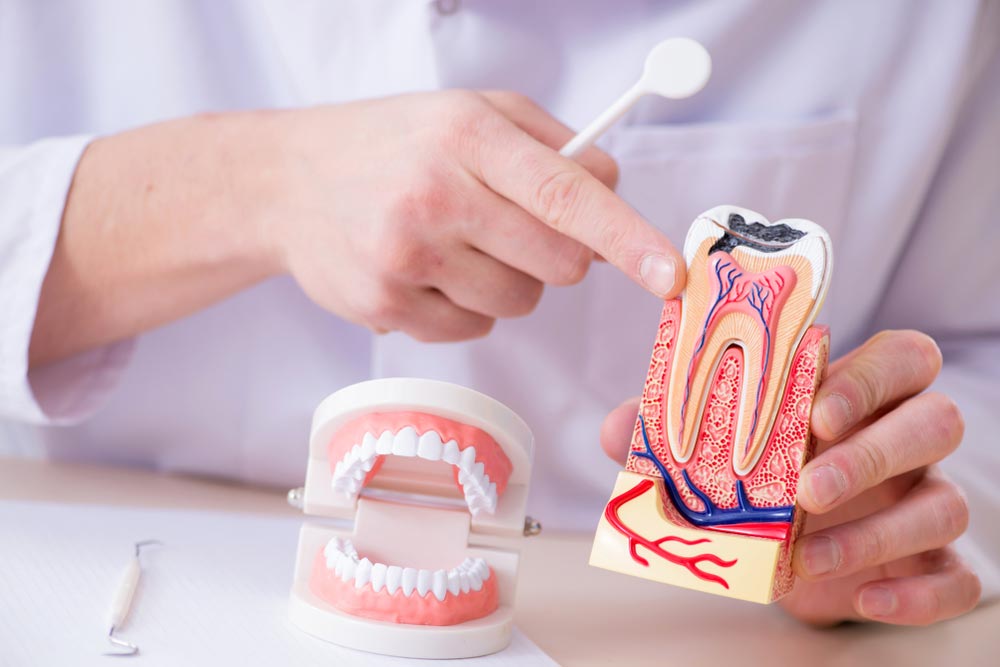Root canal treatment is an endodontic procedure used to remove infected pulp from the pulp chambers and root canals. Pulp infections, also known as pulpitis, can occur when decay-causing bacteria reach the inside of the tooth from untreated decay or a crack in the tooth. Once the inside of the tooth has been infected, a root canal becomes necessary to prevent the spread of the infection, as well as the loss of the tooth.
Did You Know?
The innermost layer of the tooth, known as the pulp, contains blood vessels and nerves. When the pulp becomes infected, it can cause pain as a result of the tooth nerve being inflamed. During a root canal, all the pulp tissue is removed, including the nerve. As a result, most patients experience significant pain relief after a root canal.
Frequently Asked Questions:
Do I need a root canal?
You will need a root canal if you have a pulp infection or if severe damage has exposed the inside of your tooth. While only Dr. Guirguis can diagnose a pulp infection, some potential symptoms that could indicate a pulp infection include:
- A single discolored tooth
- Pain localized in one tooth
- Gum irritation around one tooth
- Prolonged tooth sensitivity to hot, cold, or sweet
In some cases, a pulp infection may also not produce symptoms, especially in the early stages. This means that the need for a root canal can only be determined by Dr. Guirguis and the use of dental x-rays. If you think you may have a pulp infection, be sure to schedule an appointment with Dr. Guirguis as soon as possible.
What can I expect when having root canal treatment performed by Dr. Guirguis?
When having root canal treatment performed by Dr. Guirguis, you can first expect to have your mouth anesthetized so that you won’t feel anything during the procedure. If requested, you can also expect to receive dental sedation. Once your tooth is completely numb, Dr. Guirguis will then begin by drilling a small hole in the top or side of the affected tooth to reach the inside. Then, he will insert a series of root canal files into this hole to remove all the pulp tissue from the pulp chamber and root canals. He will then flush the inside of the tooth with an antimicrobial solution to prevent future infection.
After the pulp tissue has been removed, Dr. Guirguis will then work on restoring the tooth. To do this, he will fill the inside of the tooth with a rubber-like material known as gutta percha. In some cases, he may also place one or more small posts inside the tooth for additional stabilization. After filling the inside of the tooth, the access hole will be filled with composite resin and the remaining tooth structure will be shaped to accommodate a dental crown. Then a dental impression or oral scan will be taken of your mouth. This information will be sent to a dental laboratory and used to fabricate your custom crown. In the meantime, Dr. Guirguis will place a temporary crown to protect your teeth and maintain the necessary space for the permanent restoration. On average, it takes about 1-2 weeks for your permanent crown to be fabricated. When your permanent crown has been completed, then a second dental appointment will be needed to remove your temporary crown and replace it with the permanent crown.
Will I need to follow any special instructions after having root canal treatment?
After having root canal treatment, you should be able to drive yourself home and you can return to your normal activities. However, you will need to avoid chewing with the affected tooth to prevent the temporary crown from falling off or becoming damaged. It is also normal to experience some minor soreness following root canal treatment, especially if you were in pain before. This is due to residual inflammation from the infection and it should fade within a day or two. Once your tooth heals, Dr. Guirguis will have you return to have your permanent crown placed.


